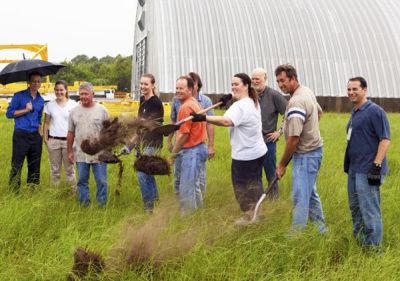KSC Building Advanced Hydrogen Fueling Facility
By Space Coast Daily // February 17, 2013
Intended To Lower Launch Costs
BREVARD COUNTY • KENNEDY SPACE CENTER, FLORIDA – Kennedy Space Center’s Engineering Directorate is constructing a new test site at the spaceport that could help reduce the cost of ground hydrogen processing operations for a variety of commercial launch vehicles and NASA’s next exploration vehicles.

Located northeast of the Hypergolic Maintenance Facility, the Ground Operations Demonstration Unit Liquid Hydrogen (GODU LH2) test site will be used to test advanced liquid hydrogen systems.
The main component of the site, the storage tank, was completed last August and a cryogenic refrigerator will be delivered in April.
“The groundbreaking is the start of a transition of a facility once used to support NASA’s Space Shuttle Program that will now help support advanced development concepts in hydrogen and energy,” said GODU LH2 Manager Bill Notardonato.
Funded by NASA’s Advanced Exploration Systems Program, the GODU LH2 test site has the potential to provide support to the Launch Services Program, the Space Launch System, Ground Systems Development and Operations and human exploration beyond low Earth orbit.
Wesley Johnson is a cryogenics engineer in the center’s Cryogenic Test Laboratory. He said a goal of the GODU test site is to become more energy efficient, and in the long run, more cost efficient, in how cryogenic propellants are handled.
“If Kennedy is to become a multiuser spaceport that serves government and commercial launches, then we will have to become cost and efficiency conscience,” Johnson said. “This project has the potential to help any launch program to lower the costs and improve the servicing of propellants to the launch vehicle.”
Johnson said the hope is that the facility will allow for the demonstration of cost and energy efficient storage and transfer of liquid hydrogen during processing, loading, launch and spaceflight.
According to Notardonato, the original 33,000-gallon tank was acquired from the old Titan Launch Complex 41 at Cape Canaveral Air Force Station.
The directorate is negotiating with United Launch Alliance to acquire a flight-weight Centaur tank for a more accurate representation of the loading demonstration. A refrigeration unit will be integrated into the storage tank.
The pneumatic system is from Launch Complex 20, with the hydrogen transfer and vent lines coming from Edwards Air Force Base in California.
After construction is complete, the tank will be used to demonstrate liquid nitrogen processing for about a year, followed by demonstration testing of liquid hydrogen.
Notardonato said the goal is to process liquid hydrogen with as little waste as possible, thereby proving economical ground cryogenics operations.












